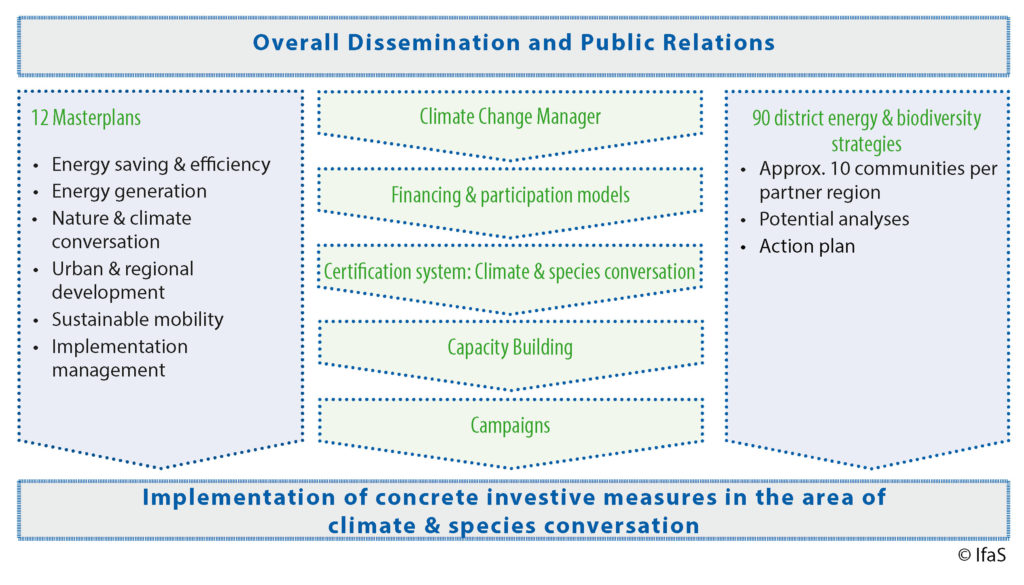The 11 project regions as well as the model community of Herrstein-Rhaunen have an individual action plan, which is to be implemented during the eight-year project period. What they all have in common is the introduction of sustainable procurement in the partner organisation. The regions and the model community also have a local Climate Change Manager to coordinate the implementation process on site. The tasks include the targeted development of regional competencies, for example through workshops and events. This, together with intensive public relations work, will have a lasting impact on raising awareness in all actors and stakeholder groups.
Masterplans, which will be developed, are the basis for the implementation of measures within the scope of the LIFE-IP ZENAPA. In the context of the masterplan development, region-specific and individual measures will be prepared. Additionally, the detailed and implementation planning is made through so called strategic biodiversity- and climate protection concepts, which are based on the integrated area concepts according to the methodology of the German KfW bank. These will be created for 90 municipalities and provide an economical basis for the implementation of the subsequent measures. In addition to analysing the potential, the master plans and concepts also take biodiversity and nature conservation aspects into account and supplement the results with these factors. Together, these ultimately form the basis for the implementation of model projects in a large number of different fields of action, which are listed below as examples:
- Species-rich energy crops,
- Pulping process for biomass,
- Biochar production,
- E-mobility,
- Energy efficiency (insulation measures, LED-lightning of buildings, streets and sports facilities),
- Energy hedges,
- Innovative storage systems,
- Waste water treatment plants,
- Low carbon meat,
- District heating,
- Natural building materials,
- Red kite management,
- Electricity- and heat generation based on renewable energies.
LIFE-IP ZENAPA aims at a broad implementation of measures not only by the actual project partners, but also by public institutions, enterprises, gastronomy, agriculture, tourism and especially citizens in the target regions. In order to push this forward and reach as many stakeholders in the project area as possible, each partner will carry out numerous thematic campaigns as well as the “1,000 Solar Roofs” programme. The project budget can only cover the costs of the project partners for the realisation of their own action plan. In order to enable the target groups outside the project consortium to carry out their own projects, LIFE-IP ZENAPA also devotes itself to the topic of financing and develops corresponding organisational models.
In order to ensure that the added value created by the implementation of measures remains in the region, innovative financing models (e.g. revolving funds, Maar & Moor Futures) and regional energy companies are planned and implemented. The development of regional funds as well as the certification model: climate and species protection will be supporting pillars for the financing of measures by different stakeholders in the catchment areas of the project partners.In the first project phase, a certificate will be developed which will evaluate criteria for CO2e savings and effects on species protection. At the same time, the monetary evaluation of these criteria as well as the definition of the obligations (e.g. period of project commitment), which a sponsor of a project to be financed has to take on, will be carried out. In order to guarantee the value and quality of the certificates, an independent valuer is commissioned to review the methodology developed. The certificates are offered on the voluntary market for emission rights (VER: Verified Emission Reductions). Potential buyers include in particular companies that purchase emission rights in excess of their legal obligations as part of their CSR (Corporate Social Responsibility) policy.
The implementation process of LIFE-IP ZENAPA is continuously accompanied by a variety of capacity building, training and public relations measures. These promote the creation of an information and competence network for the exchange of experience and mutual learning. Furthermore, the creation of cooperation among the partners is aimed at in order to develop and implement project ideas together. As a further means of project continuity, publicity reporting and the provision of information will trigger imitation effects in order to be able to make a further contribution to achieving the climate protection goals of the Federal Government and the EU even after the end of the project.
